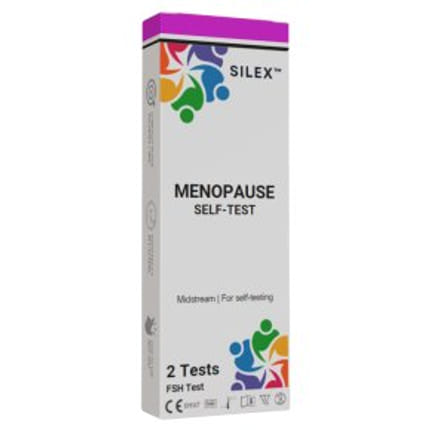

To test or not to test: how do you know if menopause has started?
Are you starting to wonder if menopause might be creeping in? You are not alone. Many women in their 40s wonder if the symptoms they are experiencing are a sign of menopause. Are you having a rough time juggling different responsibilities? Do you feel tired all the time or find yourself flying off the handle for no reason? It could be menopause. How do you know for sure if you are menopausal? Is there a test you can take? Can menopause be diagnosed by measuring hormone levels? Are there other ways to confirm menopause?
Below we explain what changes happen in the body during a woman's transition from a fertile to an infertile phase of life and what hormones play a role in this transition. And, more importantly, if there are ways to tell for sure whether you have entered perimenopause, the first stage of menopause.
Sex hormones and menopause tests
Menopause tests can be taken at a doctor’s office or at home, using a self-test. Both types of tests check hormone levels in your blood to determine whether the first stage of menopause, perimenopause, has started. The following hormone values are measured:
- Follicle-stimulating hormone (FSH):stimulates the growth of ovarian follicles (eggs) and the release of oestrogen.
- Luteinising hormone (LH): stimulates ovulation.
- Oestrogen: is produced by the ovaries and stimulates the uterus to build up extra tissue (endometrium).
- Progesterone: is secreted following ovulation and prepares the endometrium for implantation. Fact: when ovulation becomes more infrequent and eventually absent, progesterone is no longer produced.
Menopause tests measure the amount of FSH, LH and/or oestrogen in the body. The tests only tell you whether you have higher hormone levels. This doesn't mean you are definitely menopausal. Why not?
A quick recap: what happens to your hormones during menopause?
The number of eggs (follicles) in your ovaries and their quality decreases rapidly from the age of 40. You are transitioning from a fertile to an infertile phase of life. This a completely natural process.
As your ovaries release fewer follicles, your body compensates byraising FSH and LH levelsin an attempt to stimulate the remaining follicles to ovulate.
The ovaries send signals to the pituitary gland, a small organ located beneath the brain that controls the functions of a number of endocrine glands. The pituitary gland senses that the ovaries are not working properly and in turn releases FSH and LH to increase the chances of fertility.
When you're not ovulating regularly, your progesterone levels will suffer, making oestrogen more dominant. Oestrogen dominance can cause a wide range of symptoms. As you approach menopause, your oestrogen levels also start to decline (which can trigger other symptoms).
This temporary hormonal imbalance can cause a rebound effect. Your body needs time to adjust to lower hormone levels. Thankfully, our bodies are adaptable and will gradually find a new equilibrium.
Menopause test?
Sometimes tests can be misleading because of hormonal fluctuations. During perimenopause, your hormones are out of whack. One month, you may ovulate and oestrogen levels rise (which means little to no LH and FSH production), and the next month you do not (which means extra LH and FSH production).
As a result, test resultsmay come back positive one month and negative the next.Therefore, there is no point in taking a single test at a doctor’s office.
Testing yourself at different times is much more reliable. A menopause self-test checks for elevated FSH levels in your urine. By taking a menopause self-test multiple times, you will get a clear idea of your menopause status. You can purchase a self-test via SeeMe-nopause and have it delivered to your home.
It is important to understand that the height of FSH levels does not directly correlate with the severity of your symptoms. In some women, a slight dip in oestrogen, and therefore a slight increase in FSH levels, can cause severe symptoms, while in others the symptoms are mild.
Can you test for premature menopause?
Premature menopause, also referred to as premature ovarian insufficiency (POI), is when the ovaries stop working normally before the age of 40. POI affects up to 1 percent of women.
If you are 40 or younger, high FSH and oestrogen levels are considered abnormal. In this case, your GP or a self-test can confirm whether you are menopausal based on your FSH values. This only applies when menopause occurs before the age of 40 years (premature menopause).
Is it possible to diagnose menopause without testing?
It is common for hormone levels to fluctuate in the time leading up to perimenopause. Even before perimenopause occurs, women may experience subtle changes and symptoms, usually caused by oestrogen dominance. These are tell-tale signs that menopause is approaching.
One of the first signs of perimenopause, the first stage of menopause, is a change in your usual menstrual pattern. Changes can range from shorter or longer cycles, missed periods, to different bleeding patterns (heavier or lighter periods). Your periods will become more and more irregular before stopping completely: the menopause.
Every woman's experience of menopause is different. There is no set age when progression toward menopause starts. However, in general, you could say that most women aged 45 have entered perimenopause.
Greene Climacteric Scale
The Greene Climacteric Scale (GCS) is a tool used by health professionals and researchers to identify where you are on your menopause journey. The GCS asks about symptoms that may be caused by hormonal changes in the years leading up to and after menopause.
The questionnaire focuses on various menopause-related domains, including mood complaints (depression and anxiety), physical complaints and sexual concerns.The GCS can be used to find out whether your symptoms are related to menopause.
Your mother and menopause
Here’s another fun fact. Research has shown that a woman’s mother’s age at menopause appears to be a factor in her own age at menopause. In other words, the age at which your mother reached menopause is a predictor of when you’ll stop menstruating.
What symptoms your mother experienced during menopause does not provide information about what you will experience. What symptoms you will experience and how severe they will be depends mostly on your personal situation, lifestyle and overall health.
Tips and advice












